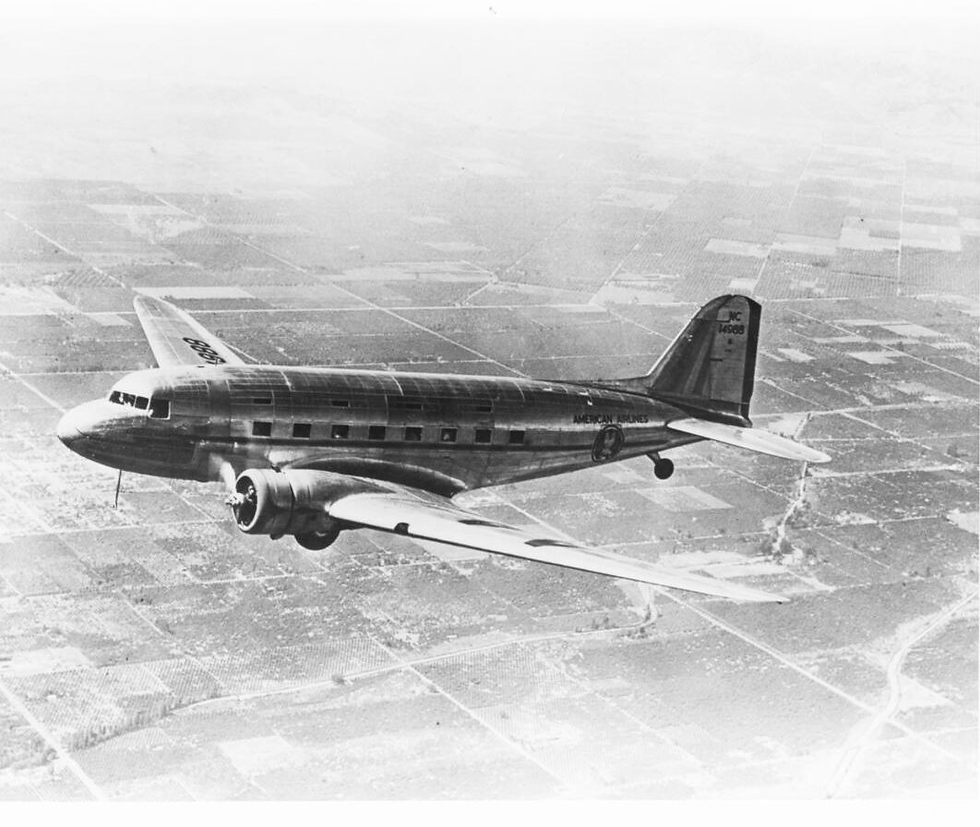By Adam Estes
While December 17 is best known as the date of the Wright Brothers' first powered flights at Kitty Hawk, NC, it is also the date in which one of the most enduring designs in aviation first took to the skies; the Douglas DC-3, which first flew on December 17, 1935
During the mid-1930s, the Douglas Aircraft Company of Santa Monica, CA was already well established as a military contractor, and starting with the one-off Douglas DC-1, the company started making significant strides into commercial aviation with the DC-2, a fast all-metal airliner that enjoyed both domestic and international success, from Transcontinental & Western Air (TWA) to KLM, and outsold its main rival, the Boeing Model 247. But as the DC-2 began entering service, American Airlines' CEO, Cyrus R. Smith, asked Donald Douglas Sr. if he could build a Sleeper Transport version of the DC-2. At the time, several airlines offered overnight flights on aircraft fitted with bunks for sleeping passengers, with flight attendants serving the needs of the wealthy passengers. Though Douglas was initially reluctant, Smith was adamant about replacing American's fleet of Curtiss T-32 Condor II biplane sleeper transports. The DC-2's fuselage was too narrow for side-by-side berths to be a suitable Sleeper Transport, and so it fell to Douglas' chief designer, Arthur E. Raymond, to lead a team to design an aircraft to Smith's specifications. The result was the Douglas Sleeper Transport (DST), which could comfortably hold 14 sleeping berths, or 28 seats for short-haul daytime travelers.
After nearly two years of work, the first DST, construction number 1494, registration NX14988, was ready for its maiden flight, which was done at Clover Field (now Santa Monica Airport), California, with Douglas Aircraft Company vice president and chief test pilot Carl A. Cover at the controls, accompanied by flight engineers Fred Stineman and Frank Coleman. Although NX14988 was the first Douglas DST/DC-3 built, it was always intended to be a production aircraft, and once the aircraft received its type, c/n 1494 became NC14988, and was sold to American Airlines on July 11, 1936, receiving the airline number A115 and the name "Flagship Texas."
On March 14, 1942, was sold to Transcontinental and Western Air (TWA) as number "361" but was impressed into service with the US Army Air Force as a C-49 with the serial number 42-43619, being assigned to the 24th Troop Carrier Squadron at Sedalia Army Air Field, MO (now Whiteman AFB). On October 15, 1942, the aircraft was destroyed during a flying accident, killing all nine occupants onboard. While the first DC-3 may have met a tragic end, it was around long enough to see the type outperform and outsell the preceding DC-2, and when WWII broke out, the DC-3 reported for duty as the C-47 Skytrain/Dakota, providing a valuable tool to the Allies' logistical network, where its rugged design saw it deliver troops and equipment to some of the most remote regions in the world, and whose use as a paratrooper transport helped signify to the peoples of Nazi-occupied Europe that liberation was upon them. After the war, many C-47s, like the soldiers they flew to and from the battlefields, left the military to go on to civilian careers, as airliners and cargo transports, but some continued to fly as military transports, from flying high-ranking officers as VIP transports, to flying supplies into West Berlin during the Berlin Airlift, to becoming some of the first gunships during the Vietnam War. There were even licensed developments to come, such as the Japanese Showa/Nakajima L2D "Tabby" and the Soviet Lisunov Li-2 "Cab."
Even today, both stock versions still powered by Pratt & Whitney radial engines and turboprop-equipped versions such as the Baseler BT-67 continue to provide active commercial service in some of the world's most remote regions, and numerous retired civilian DC-3s and ex-military C-47s/Dakotas are maintained in airworthy condition, demonstrating their capabilities at airshows around the world and giving rides to paying passengers, a true testament to an aircraft originally designed nearly 90 years ago as a sleeper transport.
Below are some photos of that first aircraft, DST N14988.

Douglas DST NX14988 during its first flight, December 17, 1935. (Douglas Aircraft Company)

DST NC14988 in flight over California (University of Southern California Library)

A nighttime publicity photo of passengers boarding Flagship Texas (NC14988), with a baggage handler holding a cart and the captain and flight attendants welcoming the passengers onboard.

NC14988 with a 1936 Cord 810 (San Diego Air and Space Museum Archives)

DST NX14988 at Clover Field (Santa Monica Airport), California. (San Diego Air and Space Museum Archives)

Comments